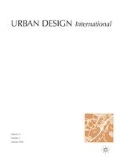Abstract
This paper explores analytical tools designed to describe urban form–space structure at a global level, eventually in quantitative mode, by a configurational approach based on the space syntax theory. The sample consists of 44 Brazilian cities, selected by demographic and cultural heritage criteria. Brazilian city configuration is contrasted with that of another 120 cities worldwide, comprising a total sample of 164 urban settlements. Analysing topological and geometrical aspects, this paper aims at revealing attributes emerging from relations among parts in a system. Urbanistic features are investigated in an endeavour to understand how different layouts can be classified into specific spatial types. The city is evaluated according to its hierarchical structure, measured mainly in terms of its topological accessibility. The approach is underpinned by the theoretical, methodological and technical apparatus of space syntax theory, employing axial map representation and its attributes. GIS tools are used to organise the database. The paper seeks to answer a question – is there a typical Brazilian city, contrasting with a world panorama? – that is limited in scope by the exploratory nature and the specific approach of the research. Four types of variables are considered, related to (1) form and distribution; (2) density and compactness; (3) topology; and (4) zoning/centralities. Three expressions summarise the findings and convey the idea of a typical Brazilian city – fragmentary space, patchwork and oasis in the labyrinth.







Similar content being viewed by others
References
Benévolo, L. (2003) História da Cidade. São Paulo, Brazil: Perspectiva.
Campos, C. (2001) Análise das redes de infra-estrutura e vazios urbanos com uso de geoprocessamento. MSc dissertation, Universidade de Brasília, Brasília.
Carvalho, S. (2002) Áreas livres para ocupação urbana no município de Salvador. MSc dissertation, Universidade Federal da Bahia, Salvador.
Coulanges, F. (2004) A Cidade Antiga. São Paulo, Brazil: Martin Claret.
Coutinho, E. (1998) O Espaço da Arquitetura. São Paulo, Brazil: Perspectiva.
Cullen, G. (1971) The Concise Townscape. London: The Architectural Press.
Hanson, J. (1992) Tradition and Experimentation in Housing and Neighborhood Design. Proceedings of the Prospects on Housing Policy and Technology Development for the 21st Century; Korea Exhibition Centre, Seoul.
Hillier, B. (1996) Space is the Machine. London: Cambridge University Press.
Hillier, B. and Hanson, J. (1984) The Social Logic of Space. London: Cambridge University Press.
Holanda, F. (2007) Arquitetura Sociológica, Proceedings from the XII Encontro Nacional da ANPUR; ANPUR, Belém.
Hopkins, W. (2006) A new view of statistics. (viewed 29 May 2006), http://sportsci.org/resource/stats/effectmag.html.
Medeiros, V. (ed.) (2006a) Brazilian Urban Form Database. Brasília: Universidade de Brasília, DIMPU Research Group.
Medeiros, V. (2006b) Urbis Brasilis ou sobre Cidades do Brasil. Doctoral thesis, Universidade de Brasília, Brasília.
Medeiros, V. (ed.) (2006c) World Urban Form Database. Brasília: Universidade de Brasília, DIMPU Research Group.
Medeiros, V., Hillier, B. and Figueiredo, L. (eds.) (2006) Space Syntax Laboratory Urban Form Database. London: University College London, Bartlett School of Graduate Studies.
Medeiros, V. and Holanda, F. (2005) Urbis Brasiliae, Proceedings from the 5th International Space Syntax Symposium; TU Delft, Delft.
Mumford, L. (1998) A Cidade na História. São Paulo, Brazil: Martins Fontes.
Panerai, P. (2006) Análise Urbana. Brasília: EdUnB.
Panerai, P., Castex, J. and Depaule, J. (1986) Formas Urbanas. Barcelona: Gustavo Gilli.
Raford, N. and Hillier, B. (2005) Correlation Landscapes. Proceedings from the 5th International Space Syntax Symposium; TU Delft, Delft.
Rosa, R. (1995) Introdução ao Sensoriamento Remoto. Uberlândia: EdUFUB.
Sitte, C. (1986) The Birth of Modern City Planning. New York: Rizzoli.
Acknowledgements
This study is supported by Coordenação de Aperfeiçoamento de Pessoal de Nível Superior (CAPES), Ministry of Education, Brazil, through a doctoral grant awarded to Valério Medeiros, and Conselho Nacional de Desenvolvimento Científico e Tecnológico (CNPq), Ministry of Science and Technology, Brazil, through a research grant awarded to Frederico de Holanda. Translation of the Portuguese original is made by the authors, and the English revision is made by Mark David Ridd.
Axial maps are to be credited as follows: Adriana Nogueira (Aracaju), Ana Barros (Belém, Braga, Coimbra, Évora, Faro, Fátima, Funchal, Macau, Óbidos, Ourém, Porto and Quito), Anirban Adhya (Ann Arbor), Api Kasemsook (Phuket), Camélia Ksumo (Delft, Leiden), Claudia Ortiz (Ciudad de Mexico), Décio Rigatti (Porto Alegre), DIMPU/UnB Research Group (Maceió, Vitória and Brasília), Edja Trigueiro (Teresina), Erica Calogero (Venezia), Fusun Erkul (Samsun), Guilherme Varela and Lucas Figueiredo (Recife), Kavyan Karimi (Hamedan, Bristol, York), Konstantinos Kypris (Nicosia), Lars Marcus (Stockholm), Laurie Neale (The Hague), Leila Alarcón (Goiânia), Loon Wai (Johor Bahru and Penang Island), Margarita Greene and Rodrigo Mora (Santiago), Mark Major (Atlanta and Chicago), Maurício Polidrolli (Pelotas), Mir Azimzadeh (Adaban, Gothenburg, Kerman, Nain, Rasht, Semnan, Shiraz and Yadz), MUsA/UFRN Research Group (Natal), Polly Fong (Manchester), Reza Nejad (Dezful), Romppanen Mervi (Helsinki), Shinichi Iida (Tokyo), Tao Yung (Beijing), Teresa Heitor (Lisbon), Valentina Karvounzi (Athens), Waffa Al-Ghatam (Muharraq and Manama), Xu Jianming (Amsterdam), Ye Arlem (Chegkan, Hongcun, Nanping, Pingshan, Tangmo, Xidi, Yuliang and Zhanqi) and Yvonne Maha (Anápolis).
Cartographic bases were obtained from Ana Queiroz (Palmas), Graciete Costa (Manaus), Iana Rufino (João Pessoa), Luciana Travassos (São Paulo), Mabel Zambuzzi (Salvador), Marcus Pereira (Fortaleza), Patrícia Trinta (São Luís), Ricardo Castor (Cuiabá), Thamara Reis (Uberlândia) and IPHAN (maps for historical Brazilian cities and towns).
Axial maps not listed above belong to the Space Syntax Laboratory/UCL urban database (special thanks to Professor Bill Hillier who made the maps available).
Author information
Authors and Affiliations
Corresponding author
Rights and permissions
About this article
Cite this article
Medeiros, V., de Holanda, F. Brazilian cities: Fragmentary space, patchwork and oasis in the labyrinth. Urban Des Int 15, 73–89 (2010). https://doi.org/10.1057/udi.2009.18
Published:
Issue Date:
DOI: https://doi.org/10.1057/udi.2009.18




